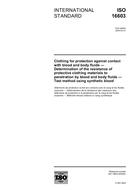We need your consent to use the individual data so that you can see information about your interests, among other things. Click "OK" to give your consent.

ISO 16603:2004
Clothing for protection against contact with blood and body fluids — Determination of the resistance of protective clothing materials to penetration by blood and body fluids — Test method using synthetic blood
Automatically translated name:
Clothing for protection against contact with blood and body fluids -- Determination of the resistance of protective clothing materials to penetration by blood and body fluids -- Test method using synthetic blood
STANDARD published on 30.3.2004
The information about the standard:
Designation standards: ISO 16603:2004
Publication date standards: 30.3.2004
SKU: NS-427180
The number of pages: 11
Approximate weight : 33 g (0.07 lbs)
Country: International technical standard
Category: Technical standards ISO
The category - similar standards:
Annotation of standard text ISO 16603:2004 :
Description / Abstract: ISO 16603:2004 describes a laboratory test method for measuring the penetration resistance of clothing materials to blood and body fluids. This test method uses a synthetic blood in continuous contact with the material specimen at specified set of conditions using the ISO 13994 test apparatus. This test method is not always effective in testing protective clothing materials having thick, inner liners which readily absorb the synthetic blood.
We recommend:
Technical standards updating
Do you want to make sure you use only the valid technical standards?
We can offer you a solution which will provide you a monthly overview concerning the updating of standards which you use.
Would you like to know more? Look at this page.



 Cookies
Cookies
